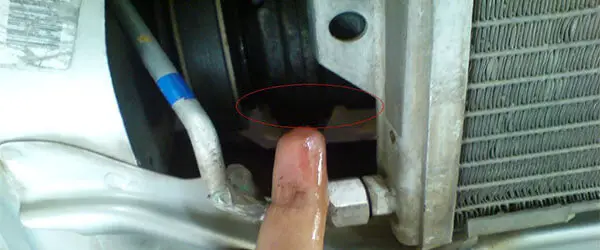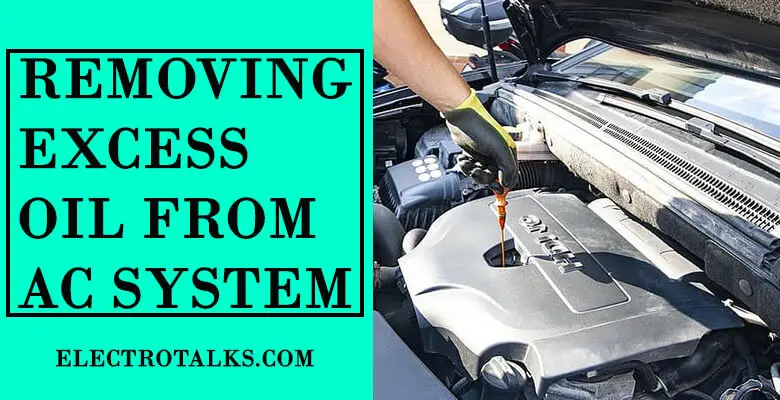“As an Amazon Associate, I earn from qualifying purchases. Without Any Extra Cost to You!”
In this modern era, you really can not think of a modern house without an AC. Now, maintaining it is one of the hassling tasks, and among them providing it with the right amount of oil is the most difficult.
Most of the time AC users find excess oil in the system causing elevated pressure, low or high temperature, system malfunctioning, and so on. Do not worry, this happens almost to all users around the world. It is very common to have leftover oil in the system.
In this short article, we are going to introduce you to some common and popular ways to remove excess oil from your AC system. You will have your AC system all back to normal in no time. We would suggest you follow the steps as they are.
It will accumulate in different parts of the system if you apply too much oil to the system and can grease the inner walls of the evaporator and condenser coils.
This will decrease their heat absorption or dissipation efficiency, thereby reducing the overall cooling output. Electrical problems may be responsible for oil pressure trips.
Any electrical problem that causes overheating of the motor windings within the compressor can cause internal compressor overloads to open up.
This will not take much of your time for you to go through the steps. Read them and apply whichever step you feel right for you. Let’s get it on with;
Removing Excess Oil From Ac System

Having excess oil in the AC system is truly frustrating. Sudden malfunctioning of the system, assume in the middle of the night, how irritating could it be? But you are not alone, almost every AC user around the world is facing this problem even once in their life.
Within a few minutes, you will read through some professional and experienced technicians recommended steps, which will help you with removing the excess oil from your AC system. This article will help you to have visible results as you follow the steps accordingly.
So without any further due, let’s get started;
1. Flush the system
An evacuation just reduces pollution and humidity. As such, the system should be broken down and the approved system components should be flushed in to remove the oil.
You should use a flush chemical of consistency in combination with compressed air to flush the elements.
Drain the push button now. Only placed it on a bench maybe for a couple of hours, or maybe overnight. Make sure the coolant is recovered after the process for ethical and environmental purposes.
You may read also swamp cooler motor won’t start
2. Refrigerant additive
Oil fouling can often contribute to excess oil. Fouling of oils is characterized as the build-up in the oil system of unwanted oil deposits. Compressors of lubrication oil do not inhibit the filling of the bobbin device with oil.
Also, the smallest volume of oil in the spiral method causes a film or cover that prevents heat transfer limiting unit production.
By using an improved silicone coolant additive such as Royal Purple, oil fouling can be minimized, and effective, and money is saved on air-cooled or water-cooled systems. Royal Purple is a stable non-corrosive liquid that is applied to the CA refrigerant, decreasing the use of AC energy and increasing cooling power.
The liquid evaporates coolant at a higher temperature and so draws heat out of the air, allowing hotter air to come out of the supply ventilation.
The liquid works with all the coolant goods increase heat transfer, provides cooler air, and prevent oil formulation.
3. Purge system or Redi Controls
In a cycle of heat and pressure variations, this device removes oil from the coolant. The pollutants are fully extracted, the extracted oil returns to the oil bucket, and the filtered channels of the refrigerant are added to the evaporator top.
And when the chiller is idle, the purge works. This is a round-the-clock approach. The facilities engineer London and Bosch agreed to buy an OAM Purger and test it out on a chiller.
The OAM Purgers come with simple directions in the vicinity of cooling vanes. Bosch and his crew agreed to set up the device themselves. In a couple of hours, it was over. It will begin extracting oil and add it to the petroleum sump until we have triggered it.
4. Flush Solvent And Compressed Air

The solvent AC Flush still seems to be preferable. Don’t flush any dissipation machines, recipients/dryers, or muffle tubes in. The easiest way to clear the lines is to flush each piece. You should use a heat exchanger.
You need the oil to clean the sump for the compressor. Drain compressor. Drain compressor. Put a few oz of the oil that you choose to use. Drag and dump the compressor a couple of times. Repeat this 3 times until the last time the compressor drains as completely as possible. Cover the case in a sealed jar of fresh oil. PAG petroleum easily absorbs moisture but doesn’t blur.
5. Vacuum the Excess Oil
Vacuuming the system may be a good idea. But you have to be very very careful. The slightest mistake may ruin the whole system. Do as provided below;
The device must be evacuated to 500 microns, and the vacuum splits with dry nitrogen. Dump nitrogen and then again evacuate to 500 microns, repeat this last time.
Do not use a vacuum for leak monitoring. You cannot detect a leak under a vacuum to contaminate the device with humidity and gas that is non-condensable. Do not shake a Schrader Valve with a vacuum. This activity enhances only the evacuation time because it is limited.
6. Flush the AC system with alcohol
Empty the coolant system according to the authorities instructions. Remove from all components you want to flush all of the pipes starting from the hole tube. Second, in the fluid line or at the evaporator. The opening tube is placed.
Located the high-side entrance on the condenser and introduce alcoholic beverages into the device through this hole. You don’t want the booze to splash around, so getaway to capture them as they sprinkle from the outlet of the condenser.
The moisture linked with the production end of the unity and guided to a bottle would be another perfect means of collecting the sweet alcohol. Continue pressurizing the condenser until the solution is no longer polluted.
Some Important FAQs
Why flushing?
Flushing is a simple way to eliminate impurities and annoying contaminants from the air conditioning system to avoid more costly road maintenance.
Evacuating an AC system of oil?
An evacuation eliminates only air and humidity. It’s not oil removal. The machine can be disassembled and parts with a unique solvent flushed to extract oil from an AC system.
If there is too much oil in the AC system?
If you apply so much oil to the system, it will pool and cover the inner surfaces of the evaporator and condenser coils at separate locations of the system.
Amount of oil needed in an AC compressor?
For certain late-model passenger car A/C systems, the overall machine oil volume is just around 4 ounces (120 ml). The compressor can hunger for oil at a low level and lead to a failure of compressor.
Final Words
We can guarantee that there is not a single AC owner who has not faced the problem of excess oil in their AC system. This is a very common incident all over the world as well as very irritating.
To save you from this awkward situation, we have arranged an article that contains 6 different steps, which are recommended by experts from all over the world.
Read through the steps accordingly. These steps will help you meet your desired, clean, well-functioning AC.
